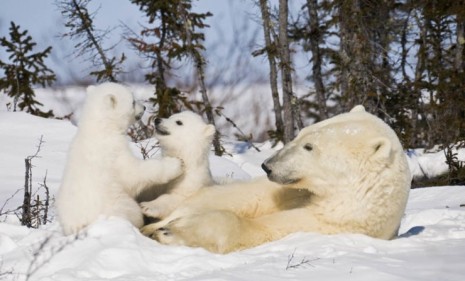5 strange facts about polar bears
The ice-dwelling mammals have something in common with President Barack Obama: A touch of Irish ancestry

Polar bears face a number of threats to their survival: As their sea ice habitat dwindles in the face of climate change, and polar bear cubs perish during arduous swims in the open ocean, lawyers continue to wrangle over whether the bears should be listed as a threatened or an endangered species. (The two designations carry different levels of legal protection.) While these challenges mount, scientists are finding out more surprising details about the animals. Here, a look at five strange facts about polar bears:
1. They're Irish: All polar bears alive today have something in common with President Obama: Irish ancestry. Each polar bear claims a common ancestor, a mama bear who lived in Ireland some 20,000 to 50,000 year ago. By extracting the DNA from ancient bear bones, researchers were able to find that one female was the source of all modern polar bears' genetic material.
2. They once mated with brown bears: Though brown bears such as grizzlies are an entirely different species, with distinct behaviors and body types, DNA research proves that polar bears and brown bears mated in the distant past. "We know that the two species have interbred opportunistically and probably on many occasions during the last 100,000 years," says researcher Beth Shapiro, as quoted by U.S. News. In fact, the Irish mama bear was a brown bear.
The Week
Escape your echo chamber. Get the facts behind the news, plus analysis from multiple perspectives.

Sign up for The Week's Free Newsletters
From our morning news briefing to a weekly Good News Newsletter, get the best of The Week delivered directly to your inbox.
From our morning news briefing to a weekly Good News Newsletter, get the best of The Week delivered directly to your inbox.
3. They're starting to mate with brown bears again: The last ice age forced brown bears into polar bear habitat, and as the two species overlapped, they began breeding with each other. Now that climate change and melting sea ice are forcing polar bears onto land to find food, they're moving into grizzly bear habitat, where the bears are producing hybrid cubs called "pizzlies" or "grolars."
4. They're setting up homes on land: Not only are polar bears moving south for food, they're also moving from sea ice onto land to find dens for rearing their cubs. According to a 20-year study by the U.S. Geological Survey, the percentage of polar bears who make dens on ice fell from 62 percent in 1985 to 37 percent in 2005.
5. They could be saved by goose eggs: As sea ice breaks up earlier in the year, polar bears have a hard time hunting on the water for seal pups, a favorite meal. So the carnivores have started eating eggs from snow goose rookeries. This doesn't threaten the survival of the snow goose: The egg-laying period for the geese overlaps just a little with the hunting season for polar bears, so the birds face only a small impact on their population numbers.
Sources: Bloomberg, LiveScience, The New York Times, NPR, Science, Treehugger, U.S. News
A free daily email with the biggest news stories of the day – and the best features from TheWeek.com
-
 Trump’s poll collapse: can he stop the slide?
Trump’s poll collapse: can he stop the slide?Talking Point President who promised to ease cost-of-living has found that US economic woes can’t be solved ‘via executive fiat’
-
 Sudoku hard: December 7, 2025
Sudoku hard: December 7, 2025The daily hard sudoku puzzle from The Week
-
 Codeword: December 7, 2025
Codeword: December 7, 2025The daily codeword puzzle from The Week
-
 Has Zohran Mamdani shown the Democrats how to win again?
Has Zohran Mamdani shown the Democrats how to win again?Today’s Big Question New York City mayoral election touted as victory for left-wing populists but moderate centrist wins elsewhere present more complex path for Democratic Party
-
 Millions turn out for anti-Trump ‘No Kings’ rallies
Millions turn out for anti-Trump ‘No Kings’ ralliesSpeed Read An estimated 7 million people participated, 2 million more than at the first ‘No Kings’ protest in June
-
 Ghislaine Maxwell: angling for a Trump pardon
Ghislaine Maxwell: angling for a Trump pardonTalking Point Convicted sex trafficker's testimony could shed new light on president's links to Jeffrey Epstein
-
 The last words and final moments of 40 presidents
The last words and final moments of 40 presidentsThe Explainer Some are eloquent quotes worthy of the holders of the highest office in the nation, and others... aren't
-
 The JFK files: the truth at last?
The JFK files: the truth at last?In The Spotlight More than 64,000 previously classified documents relating the 1963 assassination of John F. Kennedy have been released by the Trump administration
-
 'Seriously, not literally': how should the world take Donald Trump?
'Seriously, not literally': how should the world take Donald Trump?Today's big question White House rhetoric and reality look likely to become increasingly blurred
-
 Will Trump's 'madman' strategy pay off?
Will Trump's 'madman' strategy pay off?Today's Big Question Incoming US president likes to seem unpredictable but, this time round, world leaders could be wise to his playbook
-
 Democrats vs. Republicans: who are US billionaires backing?
Democrats vs. Republicans: who are US billionaires backing?The Explainer Younger tech titans join 'boys' club throwing money and support' behind President Trump, while older plutocrats quietly rebuke new administration